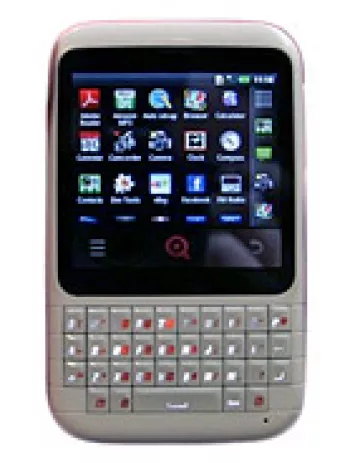
Overview of iNQ Cloud Q
The iNQ Cloud Q is a distinctive mobile device introduced by iNQ in February 2011. It was designed to cater to a unique demographic that appreciates a combination of both touch and type technology in mobile devices. Even though it was announced and generated interest, it was unfortunately cancelled before hitting the market.
Network and Connectivity
The iNQ Cloud Q was set to support GSM and HSPA technologies, which were fairly common for smartphones around 2011. Its 2G capabilities accommodated GSM 850, 900, 1800, and 1900 bands, while for 3G, it supported HSDPA bands including 900, 1900, and 2100. This ensured a robust network capability for global use, and the device supported HSPA speeds for data transfers, which was quite competitive during its announcement period.
Design and Build
The iNQ Cloud Q was crafted with practical usability in mind. It featured a physical QWERTY keyboard, which catered to users who preferred tactile feedback when typing. This choice was seen in various business-oriented devices where typing precision is prioritized. Despite the details on dimensions and weight being unspecified, the design was expected to provide comfort and efficient usability. It supported Mini-SIM technology, which was widely used before the popularity of micro and nano-SIM cards.
Display Features
The device came with a TFT resistive touchscreen capable of displaying 256,000 colors, ensuring a vibrant visual experience. The 2.6-inch screen had a resolution of 400 x 240 pixels, with a 5:3 aspect ratio and a density of approximately 179 ppi, providing clear yet compact display output suitable for quick navigation and reading.
Performance and Operating System
Under the hood, the iNQ Cloud Q was powered by the Qualcomm MSM7227 Snapdragon S1 chipset. It featured a 600 MHz ARM 11 CPU and an Adreno 200 GPU. Coupled with the Android 2.2 (Froyo) operating system, the device was positioned as a mid-range smartphone balancing productivity and performance. The OS supported various applications and services available at the time, expanding the functionality of the device greatly.
Memory and Storage
The internal storage of the iNQ Cloud Q was limited to 4MB, which was quite minimal even by 2011 standards. However, it graciously offered expandable storage via a microSDHC slot, including a 4 GB card with the phone. This allowed users to store essential documents, applications, and media files without much concern about running out of space.
Camera Specifications
The device equipped a single 5 MP autofocus primary camera, which was decent for capturing standard photos and the occasional video. Although not equipped with a front camera, the main camera catered well to basic photographic needs prevalent among smartphones of its time.
Audio and Communication
For multimedia, the phone had a competent loudspeaker and a 3.5mm audio jack, allowing connectivity to external audio devices for an enhanced listening experience. In terms of communication, it supported Wi-Fi 802.11 b/g, Bluetooth 2.1 with A2DP, GPS, A-GPS, and a microUSB 2.0 port for data transfer and charging.
Additional Features
The phone came with an accelerometer sensor for various applications and had a WAP2.0/xHTML browser for internet browsing. Despite the absence of a radio feature, it covered mainstream wireless communication standards of that era.
Battery Life
The iNQ Cloud Q featured a removable Li-Ion 1300 mAh battery. It allowed up to 200 hours of standby time and up to 4 hours of talk time, which was reasonably standard and provided comfortable use throughout the day with moderate requirements.
Color Options and Conclusion
The device was slated to come in three appealing colors: Black, White, and Red, giving consumers options to match their style preferences. Although the iNQ Cloud Q seemed promising for its market segment, it remains a what-could-have-been due to its untimely cancellation.
Key Features of iNQ Cloud Q
- Supports GSM / HSPA technology for connectivity.
- Features a QWERTY keyboard for easy typing.
- Compact 2.6-inch TFT resistive touchscreen.
- Powered by Android 2.2 (Froyo) OS.
- Includes Qualcomm MSM7227 Snapdragon S1 chipset with 600 MHz ARM 11 CPU.
- Equipped with a 5 MP autofocus main camera.
- Expandable memory via microSDHC card slot, 4 GB included.
- Provides Wi-Fi 802.11 b/g and Bluetooth 2.1 with A2DP support.
- Positioning capabilities with GPS and A-GPS.
- Includes a 3.5mm audio jack and loudspeaker.
- Removable Li-Ion 1300 mAh battery for up to 200 hours standby time.
- Available in Black, White, and Red colors.
iNQ Cloud Q Key Disadvantages
- Cancelled status, never released to the market.
- Resistive touchscreen may not be as responsive as capacitive panels.
- Low screen resolution with a pixel density of ~179 ppi.
- Runs outdated Android 2.2 (Froyo) OS, which lacks modern app support and features.
- Weak processor (600 MHz ARM 11) compared to modern devices, affecting performance.
- Extremely low internal memory of 4MB, limiting app installations and storage.
- No front camera for selfies or video calls.
- Lacks FM radio, which is a common feature in many phones.
- Short battery talk time of up to 4 hours, requiring frequent recharging.
View Also
More Phones
All Rights Reserved +13693 Phones © Mobilawy 2025

















